Intracellular targeting signals and lipid specificity determinants of the ALA/ALIS P4-ATPase complex reside in the catalytic ALA alpha-subunit
- PMID: 20053675
- PMCID: PMC2828965
- DOI: 10.1091/mbc.e09-08-0656
Intracellular targeting signals and lipid specificity determinants of the ALA/ALIS P4-ATPase complex reside in the catalytic ALA alpha-subunit
Abstract
Members of the P(4) subfamily of P-type ATPases are believed to catalyze flipping of phospholipids across cellular membranes, in this way contributing to vesicle biogenesis in the secretory and endocytic pathways. P(4)-ATPases form heteromeric complexes with Cdc50-like proteins, and it has been suggested that these act as beta-subunits in the P(4)-ATPase transport machinery. In this work, we investigated the role of Cdc50-like beta-subunits of P(4)-ATPases for targeting and function of P(4)-ATPase catalytic alpha-subunits. We show that the Arabidopsis P(4)-ATPases ALA2 and ALA3 gain functionality when coexpressed with any of three different ALIS Cdc50-like beta-subunits. However, the final cellular destination of P(4)-ATPases as well as their lipid substrate specificity are independent of the nature of the ALIS beta-subunit they were allowed to interact with.
Figures

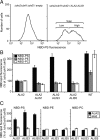
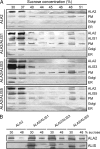
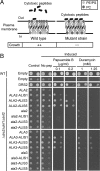
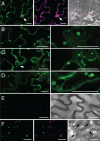
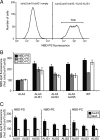
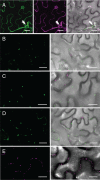
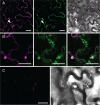
Similar articles
-
Role of post-translational modifications at the β-subunit ectodomain in complex association with a promiscuous plant P4-ATPase.Biochem J. 2016 Jun 1;473(11):1605-15. doi: 10.1042/BCJ20160207. Epub 2016 Apr 5. Biochem J. 2016. PMID: 27048590 Free PMC article.
-
CDC50 proteins are critical components of the human class-1 P4-ATPase transport machinery.J Biol Chem. 2010 Dec 24;285(52):40562-72. doi: 10.1074/jbc.M110.139543. Epub 2010 Oct 20. J Biol Chem. 2010. PMID: 20961850 Free PMC article.
-
Mechanism and significance of P4 ATPase-catalyzed lipid transport: lessons from a Na+/K+-pump.Biochim Biophys Acta. 2009 Jul;1791(7):603-11. doi: 10.1016/j.bbalip.2009.02.005. Epub 2009 Feb 21. Biochim Biophys Acta. 2009. PMID: 19233312 Review.
-
ATPase reaction cycle of P4-ATPases affects their transport from the endoplasmic reticulum.FEBS Lett. 2020 Feb;594(3):412-423. doi: 10.1002/1873-3468.13629. Epub 2019 Oct 14. FEBS Lett. 2020. PMID: 31571211
-
P4 ATPases--the physiological relevance of lipid flipping transporters.FEBS Lett. 2010 Jul 2;584(13):2708-16. doi: 10.1016/j.febslet.2010.04.071. Epub 2010 May 7. FEBS Lett. 2010. PMID: 20450914 Review.
Cited by
-
P4 ATPases: flippases in health and disease.Int J Mol Sci. 2013 Apr 11;14(4):7897-922. doi: 10.3390/ijms14047897. Int J Mol Sci. 2013. PMID: 23579954 Free PMC article. Review.
-
Identification of residues defining phospholipid flippase substrate specificity of type IV P-type ATPases.Proc Natl Acad Sci U S A. 2012 Feb 7;109(6):E290-8. doi: 10.1073/pnas.1115725109. Epub 2012 Jan 20. Proc Natl Acad Sci U S A. 2012. PMID: 22308393 Free PMC article.
-
Entamoeba histolytica "mutator" strain with a high rate of genetic mutations assists the elucidation of drug resistance mechanisms.Microbiol Spectr. 2025 Aug 5;13(8):e0121025. doi: 10.1128/spectrum.01210-25. Epub 2025 Jun 12. Microbiol Spectr. 2025. PMID: 40503832 Free PMC article.
-
P-Type ATPase Apt1 of the Fungal Pathogen Cryptococcus neoformans Is a Lipid Flippase of Broad Substrate Specificity.J Fungi (Basel). 2021 Oct 8;7(10):843. doi: 10.3390/jof7100843. J Fungi (Basel). 2021. PMID: 34682264 Free PMC article.
-
Lipid flippases as key players in plant adaptation to their environment.Nat Plants. 2021 Sep;7(9):1188-1199. doi: 10.1038/s41477-021-00993-z. Epub 2021 Sep 16. Nat Plants. 2021. PMID: 34531559 Review.
References
-
- Axelsen K. B., Palmgren M. G. Evolution of substrate specificities in the P-type ATPase superfamily. J. Mol. Evol. 1998;46:84–101. - PubMed
-
- Brandizzi F., Fricker M., Hawes C. A greener world: the revolution in plant bioimaging. Nat. Rev. Mol. Cell Biol. 2002;3:520–530. - PubMed
-
- Chantalat S., Park S. K., Hua Z., Liu K., Gobin R., Peyroche A., Rambourg A., Graham T. R., Jackson C. L. The Arf activator Gea2p and the P-type ATPase Drs2p interact at the Golgi in Saccharomyces cerevisiae. J. Cell Sci. 2004;117:711–722. - PubMed
Publication types
MeSH terms
Substances
LinkOut - more resources
Full Text Sources
Molecular Biology Databases

